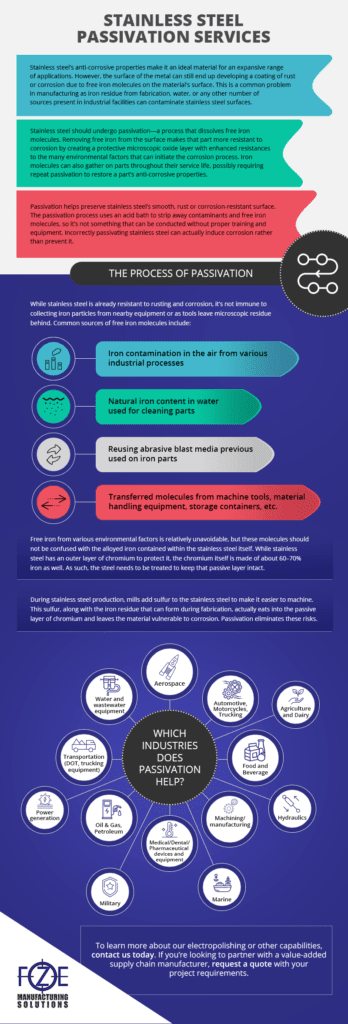Passivation
Stainless steel’s anti-corrosive properties make it an ideal material for an expansive range of applications. However, the surface of the metal can still end up developing a coating of rust or corrosion due to free iron molecules on the material’s surface. This is a common problem in manufacturing as iron residue from fabrication, water, or any other number of sources present in industrial facilities can contaminate passivated stainless steel surfaces.
Stainless steel should undergo passivation of stainless steel—a process that dissolves free iron molecules. The passivation of stainless steel involves removing free iron from the surface to make it more resistant to corrosion by creating a protective microscopic oxide layer with enhanced resistances to the many environmental factors that can initiate the corrosion process. Iron molecules can also gather on parts throughout their service life, possibly requiring repeat stainless steel passivation to restore a part’s anti-corrosive properties.
Passivation helps preserve passivated stainless steel’s smooth, rust or corrosion-resistant surface. The passivation of stainless steel process uses an acid bath to strip away contaminants and free iron molecules, so it’s not something that can be conducted without proper training and equipment. Incorrectly passivated stainless steel can actually induce corrosion rather than prevent it.
Get In Touch Today
Fill out the form below to start a conversation
The Process of Passivation
While stainless steel is already resistant to rusting and corrosion, it’s not immune to collecting iron particles from nearby equipment or as tools leave microscopic residue behind. Common sources of free iron molecules include:
- Iron contamination in the air from various industrial processes
- Natural iron content in water used for cleaning parts
- Reusing abrasive blast media previously used on iron parts
- Transferred molecules from machine tools, material handling equipment, storage containers, etc.
Free iron from various environmental factors is relatively unavoidable, but these molecules should not be confused with the alloyed iron contained within the passivated stainless steel itself. While stainless steel has chromium and nickel to protect it, the chromium and nickel itself is made of about 60–70% iron. As such, the stainless steel needs to be treated to keep that passive layer intact.
During stainless steel production, mills add sulfur to the stainless steel to make it easier to form and machine. This sulfur, along with the iron residue that can form during fabrication, actually eats into the passive layer of chromium and leaves the material vulnerable to corrosion. Passivation stainless steel eliminates these risks.
Passivation Step by Step
The stainless steel passivation process follows these steps:
- The stainless-steel item first undergoes cleaning with an alkaline-based cleaner. This removes surface contaminants, including iron molecules, grease, and oils that may have been left on the part.
- Next, the part is rinsed with deionized (DI) water and then placed in an acid bath to dissolve the iron—typically nitric or citric acid. FZE uses a citric acid bath and this is when the protective passive layer forms on the part.
- A second rinse with DI water follows, and then the part is air dried.
- A final testing stage tests the material’s resistance to salt sprays and other corrosive materials such as copper sulfate.
Passivation Benefits
Passivation stainless steel protects stainless steel from corrosion and rust, extending the usable service life of parts and components made from this material. In addition, stainless steel passivation doesn’t affect the surface of the metal itself, unlike some other surface finishing or surface treatments that may eat into or strip away metal from the outer surface. It only strips away contaminants and iron from the surface of the stainless steel.
Nothing is introduced into or onto the steel—the passive layer would form naturally in nature under optimal circumstances. As a bonus, FZE uses a citric acid process which is eco-friendly and relatively safe to use as compared to nitric acid.
Which Industries Does Passivation Help?
Realistically, stainless steel passivation helps any industry that uses stainless steel components. In particular, however, passivation is necessary for:
- Aerospace
- Automotive, Motorcycles, Trucking
- Agriculture and Dairy
- Food and Beverage
- Hydraulics
- Machining/manufacturing
- Marine
- Medical/Dental/Pharmaceutical devices and equipment
- Military
- Oil & Gas, Petroleum
- Power generation
- Transportation (DOT, trucking equipment)
- Water and wastewater equipment
Work With FZE Manufacturing
FZE stands out as a leader in stainless steel passivation. We have been around for 50-years since 1974, offering a range of manufacturing expertise for five decades. We have certifications that display our dedication to efficiency and quality in all of our processes and services, such as:
- Lean Six Sigma (Black Belt)
- ISO 9001:2015 Certified
- Kaizen/5S and Lean manufacturing
Our broader range of services includes Assembly and Sub-Assembly Kitting, Just-in-Time (JIT) manufacturing, inventory management, supply-chain management and optimization, and over-all fully landed cost reductions. Onsite consultations and inspection services are also available, including dimensional and visual inspections, optical monitoring and customized packaging. We can also accommodate quick turnaround times and rush orders and have a proven track record of on-time delivery performance.
For more information about passivation stainless steel or any of our other services and capabilities, please contact us or request a quote.
For more information about passivation or any of our other services and capabilities, please contact us or request a quote.
Contact Us Request For Quote
